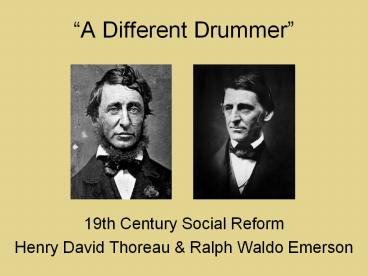A Different Drummer - PowerPoint PPT Presentation
1 / 14
Title:
A Different Drummer
Description:
A Different Drummer 19th Century Social Reform Henry David Thoreau & Ralph Waldo Emerson Standard 8.6.7 Identify common themes in American art as well as ... – PowerPoint PPT presentation
Number of Views:41
Avg rating:3.0/5.0
Title: A Different Drummer
1
A Different Drummer
- 19th Century Social Reform
- Henry David Thoreau Ralph Waldo Emerson
2
Standard 8.6.7
- Identify common themes in American art as well as
transcendentalism and individualism (e.g.,
writings about and by Ralph Waldo Emerson and
Henry David Thoreau.
3
- transcendentalists
- writers and thinkers in New England who believed
the most important truths in life transcend or go
beyond human reason - transcendentalism
- stressed emotion over reason
- believed that an individual has control over his
or her life - the beliefs of transcendentalists led them to
support social reform as a way of improving
America in the mid-1800s - two important transcendentalists were Ralph Waldo
Emerson and Henry David Thoreau
- Who were the transcend-
- entalists and what did
- they believe?
Ralph Waldo Emerson
4
- Ralph Waldo Emerson
- popular essayist lecturer
- spoke and wrote about self reliance and character
- Emerson believed
- the human sprit was reflected in nature
- nature held higher values that came from God
- in the importance of the individual
- Emerson urged people to use their inner light
to guide their lives and improve society
- What ideas did Emerson
- express in his writings
- and speeches?
A man should learn to detect and watch that
gleam of light which flashes across his mind from
within.
The Inner Light
5
Nature always wears the color of the spirit.
Ralph Waldo Emerson
6
Simplify!
7
- What ideas did Thoreau
- express in his writings?
- Henry David Thoreau
- Emersons friends and neighbor
- Thoreau believed that the growth of industry and
the rise of cities were ruining the nation - Thoreau urged people to live as simply as
possible - his best known work is Walden
- the book describes spending a year alone in a
cabin on Walden Pond in Massachusetts - Thoreau believed that an individual must decide
what is right and wrong - Thoreaus ideas and actions were part of a
mounting wave of reform activism that had begun
in the 1840s
8
- The law will never make men free, it is men who
have got to make the law free.
9
Thoreau on Nature Self Examination
A lake is the landscape's most beautiful and
expressive feature. It is Earth's eye looking
into which the beholder measures the depth of his
own nature.
10
- Civil Disobedience
- Thoreau argued that people had a right and a duty
to disobey unjust laws if their consciences
demanded it - went to jail for refusing to pay taxes to support
the Mexican War which he felt promoted slavery - Thoreaus beliefs told him slavery was wrong and
he took direct action to end it - delivered several lectures in opposition to the
enforcement of the Fugitive Slave Law - as an abolitionist he worked as a conductor on
the Underground Railroad helping escaped slaves
reach freedom
- In what ways did Thoreaus
- beliefs contribute to social
- reform?
11
Why are Emersons and Thoreaus ideas
important today?
- Nonviolent Protest
- Thoreaus writings and actions influenced people
both during his life and after his death - In the 20th century, Mohandas K. Gandhi (India)
and both Martin Luther King Jr. and Cesar Chavez
(America) are all examples of people extending
Thoreau's individual model onto huge scales of
mass action
12
Review
- Answer the following questions using the
information you learned - from the presentation.
- 1. According to Emerson and Thoreau, how does a
single individual recognize what is wrong and
what is right? - 2. At what point, and by what right, does a
person's conscience carry more authority than the
law? - 3. List some examples of what can be
accomplished by acts of civil disobedience? - 4. What is important about the idea of civil
disobedience in our own time?
13
Group Activity - Create a Chart
- Pretend that Henry David Thoreau is returning to
look at - todays society. He will spend a week in your
community. - Make a two-column chart. In the left column, list
things, - places, activities, or ideas that he would most
likely criticize. - On the right, list things, places, activities, or
ideas that he - would most likely appreciate. Be prepared to
explain your - chart to the class.
14
Sources
- http//www.vcu.edu/engweb/transcendentalism/author
s/thoreau/walden/ - http//www.thoreau.niu.edu/images/graphics/back_im
age_thoreau.gif - http//library.thinkquest.org/27864/data/thoreau/h
dthome.html - http//www.vcu.edu/engweb/transcendentalism/images
/thoreau-titlepage.gif - http//www.ilstu.edu/czimmer/newphotos.html
- http//plato.stanford.edu/entries/emerson/Emerson.
jpg - http//www.unit5.org/schermann/images/mountain.jpg
- http//www.swarthmore.edu/Humanities/kjohnso1/pict
ures/cole1.jpg - http//www.byrdcallstudio.com/Henry-David-Thoreau-
-close-.jpg
Castillo, Davidson, Stoff, The American Nation,
Prentice Hall, 2000, p. 341-343































